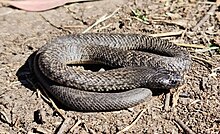| Blue-bellied black snake | |
|---|---|

| |
| Conservation status | |
 Least Concern (IUCN 3.1) | |
| Scientific classification | |
| Domain: | Eukaryota |
| Kingdom: | Animalia |
| Phylum: | Chordata |
| Class: | Reptilia |
| Order: | Squamata |
| Suborder: | Serpentes |
| Family: | Elapidae |
| Genus: | Pseudechis |
| Species: | P. guttatus |
| Binomial name | |
| Pseudechis guttatus De Vis, 1905 | |
| Synonyms | |
| |
The blue-bellied black snake (Pseudechis guttatus), also known commonly as the spotted black snake, is a species of venomous snake in the family Elapidae. The species is native to Australia.
Geographic range
P. guttatus is endemic to the inland areas of south-eastern Queensland and north-eastern New South Wales, Australia.
Habitat
The preferred natural habitats of P. guttatus are grassland, shrubland, and savanna.
Description
On average, P. guttatus grows to a total length (including tail) of 1.2 m (3.9 ft), but some specimens have been found to measure as long as 1.5 m (4.9 ft).
Diet
P. guttatus is carnivorous. Its diet consists of frogs, lizards, and small mammals.
Reproduction
P. guttatus, like most other snakes, is oviparous, laying 7–12 eggs during the breeding season.
Venom
The average venom ejection of P. guttatus is unknown. The snake's venom is the second most toxic of all the Australian black snakes. It is naturally very shy, and will not bite unless provoked (by being stepped on by a boot, prodded by a stick, etc.). A human, if bitten, may suffer severe pain, nausea, vomiting, diarrhoea, diaphoresis and regional lymphadenopathy at the location of the bite, similar to a red-bellied black snake's bite symptoms. Bites are infrequent. If bitten, tiger snake antivenom is the preferred treatment.
References
- ^ Hobson, R.; Wilson, S.; Sanderson, C. (2018). "Pseudechis guttatus". IUCN Red List of Threatened Species. 2018: e.T42493239A42493245. doi:10.2305/IUCN.UK.2018-1.RLTS.T42493239A42493245.en. Retrieved 18 November 2021.
- Species Pseudechis guttatus at The Reptile Database www.reptile-database.org.
- ^ "Spotted Black Snake (Pseudechis guttatus)".
- Jansen, Melanie; McLeod, Monique; White, Julian; Isbister, Geoffrey K. (January 2007). "Spotted black snake (Pseudechis guttatus) envenoming". Medical Journal of Australia. 186 (1): 41–42. doi:10.5694/j.1326-5377.2007.tb00788.x. PMID 17229034. S2CID 27460738.
- "Australian Venom Research Unit". 13 January 2021.
Further reading
- Cogger HG (2014). Reptiles and Amphibians of Australia, Seventh Edition. Clayton, Victoria, Australia: CSIRO Publishing. xxx + 1,033 pp. ISBN 978-0643100350.
- De Vis CW (1905). "A New Genus of Lizards". Annals of the Queensland Museum 6: 46–52. (Pseudechis guttata, new species, pp. 49–50).
- Wilson S, Swan G (2013). A Complete Guide to Reptiles of Australia, Fourth Edition. Sydney: New Holland Publishers. 522 pp. ISBN 978-1921517280.
| Taxon identifiers | |
|---|---|
| Pseudechis guttatus | |
This snake article is a stub. You can help Misplaced Pages by expanding it. |